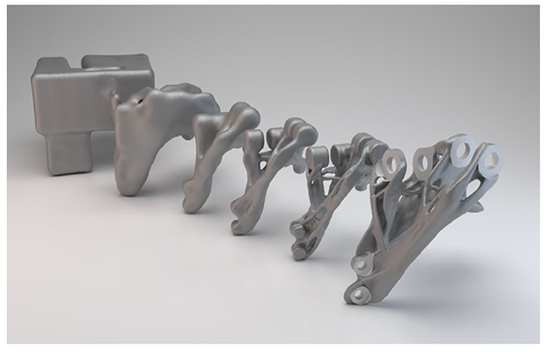Key takeaways:
- Generative design is the initial step toward a vision of automatic creation of model geometry that fully meets design requirements.
- The uncomplicated setup and execution of MSC Apex Generative Design does not require highly skilled simulation experts.
- MSC Apex Generative Design exports proper geometry after each iteration allowing the user to view the algorithm’s progress and potentially make changes to explore various design alternatives.
- MSC Apex Generative Design offers its users a high degree of automation and in combination with a smooth workflow can accelerate time-to-market.
To gain a competitive advantage, product designers seek to use the latest technology but do not want the burden of having to use highly skilled resources. Hexagon (www.hexagon.com), a global provider of information technologies that drive manufacturing productivity, acquired MSC Software in 2017 and developed the Apex Generative Design solution to deliver on that goal.[1] CIMdata defines generative design as a process wherein the shape and composition of a product are determined by using physics-based simulation and other analysis methods that consider performance requirements and optimize objectives such as minimum cost and weight.

Figure 1—Satellite Bracket Generated using MSC Apex Generative Design is more Lightweight while Reducing the Overall Stress Level
(Courtesy of Hexagon)
MSC Apex Generative Design fulfills that mission, allowing the creation of designs that are tailored for additive manufacturing (AM). Once given start conditions by the user, the MSC Apex Generative Design algorithms automatically mesh, analyze, optimize, interpret analysis results, and execute model smoothing as they rapidly iterate toward attaining user-specified goals. The performance of the solution allows a designer to explore different design candidates. Each resulting model structure is fully adapted for AM production. CIMdata concurs with the Hexagon strategy of providing a solution that minimizes the requirement of skilled experts in simulation and AM.
The Challenge
The traditional method of design uses a “model then analyze and modify” iteration that takes time with geometry often being passed back and forth between design engineers and CAE specialists. Generative design turns the traditional approach on its head. Generative design algorithms themselves perform both the analysis and geometry modification cycle. The algorithms are capable of processing numerous model permutations seeking an optimum solution specified by the user. However, many generative design solutions in the market still require a design engineer, specialized CAE analyst, and additive manufacturing expert to accomplish the goal of an optimized, manufacturable model.
Hexagon promises that MSC Apex Generative Design does not require a team of specialists. The user first specifies the design space of the model—the bounded volume within which the model must be contained, including “keep out” areas that are necessary for mounting the resultant model in a larger assembly. Next, the designer identifies the material of the model and the analysis goals, such as minimizing material, therefore weight, or optimizing structural strength. MSC Apex Generative Design then takes over and rapidly performs the iterative calculations.

Figure 2—Iterative Optimization Steps using MSC Apex Generative Design where Every Iteration is Displayed and can be Exported
(Courtesy of Hexagon)
MSC Apex Generative Design exports a proper geometric model after each iteration. This allows the designer to view the optimization progress to check whether it is heading in the right direction. If needed the designer can adapt the model to refine or alter the direction of the optimization to explore other potential solutions. CIMdata views this flexibility as adding more control for the designer in interactively arriving at an optimized model. The fact that parameters can be changed to generate different design variants allows the designer to explore more alternatives and helps foster innovation. Hexagon reports they have done extensive tuning of MSC Apex Generative Design to exploit both CPU and GPU power to offer increased productivity.
Summary
The growth of generative design methods is driving new levels of innovation and optimization across product development. The methodology, with its ties to additive manufacturing, is resulting in products that were impossible to realize with traditional subtractive manufacturing technology and traditional design development processes. Hexagon’s MSC Apex Generative Design, with its easy setup, ability to deliver viable models at each step in the optimizing iteration, and its adaptability to drive AM is helping spearhead new inroads of innovation in product development. CIMdata recognizes the significance of MSC Apex Generative Design and the benefits it brings design engineers. Companies would do well to explore the solution as a strong addition to their tool portfolio.




